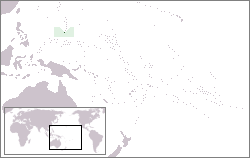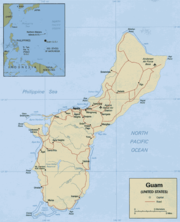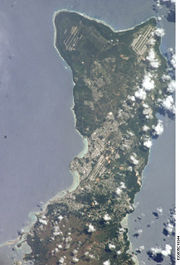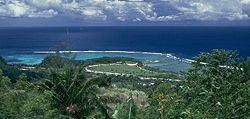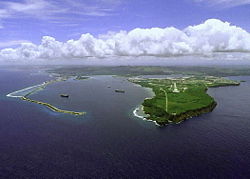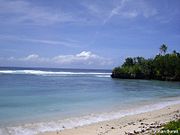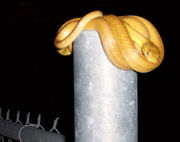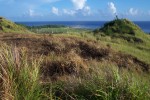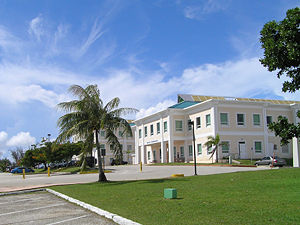Guam
2008/9 Schools Wikipedia Selection. Related subjects: Geography of Oceania (Australasia)
| Territory of Guam Guåhån |
||||||
|---|---|---|---|---|---|---|
|
||||||
| Motto: "Where America's Day Begins" | ||||||
| Anthem: Fanohge Chamoru |
||||||
|
|
||||||
| Capital | Hagåtña | |||||
| Largest village | Dededo | |||||
| Official languages | English and Chamorro | |||||
| Demonym | Guamanian | |||||
| Government | ||||||
| - | President | George W. Bush ( R) | ||||
| - | Governor | Felix Perez Camacho (R) | ||||
| Area | ||||||
| - | Total | 541.3 km² ( 192nd) 209 sq mi |
||||
| - | Water (%) | negligible | ||||
| Population | ||||||
| - | July 2007 estimate | 173,456 ( 179th) | ||||
| - | 2000 census | 154,805 | ||||
| - | Density | 320/km² ( 37th) 830/sq mi |
||||
| GDP ( PPP) | 2000 estimate | |||||
| - | Total | $3.2 billion ( 167th) | ||||
| - | Per capita | $21,0001 ( 35th) | ||||
| Currency | United States dollar ( USD) |
|||||
| Time zone | Chamorro Standard Time ( UTC+10) | |||||
| Internet TLD | .gu | |||||
| Calling code | +1 671 | |||||
| 1 | 2000 estimate. | |||||
Guam ( Chamorro: Guåhån), officially the Territory of Guam, is an island in the Western Pacific Ocean and is an organized, unincorporated territory of the United States. It is one of five U.S. territories with an established civilian government. The island's capital is Hagåtña (formerly Agana). Guam is the largest and southernmost of the Mariana Islands.
The Chamorros, Guam's indigenous inhabitants, first populated the island approximately 4,000 years ago. The island has a long history of European colonialism beginning in 1668 with the arrival of Spanish settlers including Padre San Vitores, a Catholic missionary. The island was taken over from Spain by the United States during the Spanish American War in 1898. As the largest island in Micronesia and the only American-held island in the region before World War II, Guam was occupied by the Japanese between December 1941 and July 1944. Today, Guam's economy is mainly supported by tourism (primarily from Japan) and U.S. military bases.
History
It is believed that Guam was first discovered by sea-faring people who migrated from southeastern Indonesia around 2000 B.C. Most of what is known about Pre-Contact ("Ancient") Chamorros comes from legends and myths, archaeological evidence, Jesuit missionary accounts, and observations from visiting scientists like Otto von Kotzebue and Louis de Freycinet.
When Europeans first arrived on Guam, Chamorro society roughly fell into three classes: matua (upper class), achaot (middle class), and mana'chang (lower class). The matua were located in the coastal villages, which meant they had the best access to fishing grounds while the mana'chang were located in the interior of the island. Matua and mana'chang rarely communicated with each other, and matua often used achaot as a go-between. There were also "makana" (shamans), skilled in healing and medicine. Belief in spirits of ancient Chamorros called Taotao Mona still persists as a remnant of pre-European society. Early European explorers noted the Chamorros' fast sailing vessels used for trading with other islands of Micronesia.
The Latte Stones familiar to Guam residents and visitors alike were in fact a recent development in Pre-Contact Chamorro society. The latte stone consists of a head and a base shaped out of limestone. Archaeologists using carbon-dating have broken Pre-Contact Guam (i.e. Chamorro) history into three periods: "Pre-Latte" (B.C. 2000? to A.D. 1) "Transitional Pre-Latte" (A.D. 1 to A.D. 1000), and "Latte" (A.D. 1000 to A.D. 1521). Archaeological evidence also suggests that Chamorro society was on the verge of another transition phase by 1521, as latte stones became bigger. Assuming the stones were used for chiefly houses, it can be argued that Chamorro society was becoming more stratified, either from population growth or the arrival of new people. The theory remains tenuous, however, due to lack of evidence, but if proven correct, will further support the idea that Pre-Contact Chamorros lived in a vibrant and dynamic environment.
Portuguese navigator Ferdinand Magellan, sailing for the King of Spain, reached the island in 1521 during his circumnavigation of the globe. General Miguel López de Legazpi claimed Guam for Spain in 1565. Spanish colonization commenced in 1668 with the arrival of Padre San Vitores, who established the first Catholic mission. The islands were then governed as part of the Spanish East Indies from the Philippines. Between 1668 and 1815, Guam was an important resting stop for the Spanish Manila galleons, a fleet that covered the trade route between Mexico and the Philippines. Guam, along with the rest of the Mariana and Caroline Islands, was treated by Spain as part of their colony in the Philippines. While Guam's Chamorro culture is unique, the cultures of both Guam and the Northern Marianas were heavily influenced by Spanish culture and traditions.
The United States took control of the island in the 1898 Spanish-American War. Guam came to serve as a station for American ships traveling to and from the Philippines, while the northern Mariana islands passed to Germany then Japan. During World War II, Guam was attacked, and invaded, by the armed forces of Japan on December 8, 1941. Before the attack, most of the United States citizens were transported from the island and away from imminent danger. The Northern Mariana Islands had become a Japanese protectorate before the war. It was the Chamorros from the Northern Marianas who were brought to Guam to serve as interpreters and in other capacities for the occupying Japanese force. The Guamanian Chamorros were treated as an occupied enemy by the Japanese military. After the war, this would cause some resentment by the Guamanian Chamorros towards the Chamorros in the Northern Marianas. Guam's occupation lasted for approximately thirty-one months. During this period, the indigenous people of Guam were subjected to forced labor, family separation, incarceration, execution, concentration camps and prostitution. Approximately one thousand people died during the occupation according to Congressional Testimony in 2004. The United States returned and fought the Battle of Guam on July 21, 1944, to recapture the island from Japanese military occupation. To this day, Guam remains the only U.S. soil with a sizable population to have ever been occupied by a foreign military power, other than the limited British occupation of U.S. territory during the War of 1812. The United States also captured and occupied the Northern Marianas. After the war, the Guam Organic Act of 1950, which established Guam as an unincorporated organized territory of the United States, provided for the structure of the island's civilian government and granted the people U.S. citizenship.
Geography
Guam lies between 13.2°N and 13.7°N and between 144.6°E and 145.0°E, and has an area of 209 square miles (541 km²), making it the 32nd largest island of the United States. It is the southernmost island in the Mariana island chain and is the largest island in Micronesia. This island chain was created by the colliding Pacific and Philippine tectonic plates. The Marianas Trench, a deep subduction zone, lies beside the island chain to the east. Challenger Deep, the deepest surveyed point in the Oceans, is southwest of Guam at 35,797 feet (10,911 m) deep. The highest point in Guam is Mount Lamlam, which is 1,332 feet (406 m). The island of Guam is 30 miles (48 km) long and 4 mi (6 km) to 12 mi (19 km) wide. The island experiences occasional earthquakes due to it being on the western edge of the Pacific Plate and near the Philippine Plate. In recent years, earthquakes with epicenters near Guam have had magnitudes ranging from 5.0 to 8.7. Unlike the Anatahan volcano in the Northern Mariana Islands, Guam is not volcanically active. However, due to its proximity to Anatahan, vog does occasionally affect Guam.
The northern part of the island is a forested coralline limestone plateau while the south contains volcanic peaks covered in forest and grassland. A coral reef surrounds most of the island, except in areas where bays exist that provide access to small rivers and streams that run down from the hills into the Pacific Ocean and Philippine Sea. The island's population is most dense in the northern and central regions.
Climate
The climate is characterized as tropical marine. The weather is generally hot and very humid with little seasonal temperature variation. The mean high temperature is 86 ° F (30 ° C) and mean low is 76 ° F (24 °C) with an average annual rainfall of 96 inches (2,180 mm). The dry season runs from December through June. The remaining months constitute the rainy season. The months of January and February are considered the coolest months of the year with night time temperatures in the mid to low 70's and generally lower humidity levels. The highest risk of typhoons is during October and November. They can occur, however, year-around.
An average of three tropical storms and one typhoon pass within 180 nautical miles (330 km) of Guam each year. The most intense typhoon to pass over Guam recently was Super Typhoon Pongsona, with sustained winds of 125 miles per hour, which slammed Guam on December 8, 2002, leaving massive destruction. Since Super Typhoon Pamela in 1976 wooden structures have been largely replaced by concrete structures. During the 1980s wooden utility poles began to be replaced by typhoon-resistant concrete and steel poles. After the local Government enforced stricter construction codes, many home and business owners built their structures out of reinforced concrete with installed typhoon shutters.
Demographics
According to the U.S. census conducted in 2000, the population of Guam was 154,805. The 2007 population estimate for Guam is 173,460. As of 2005, the annual population growth is 1.76%. The largest ethnic group are the native Chamorros, accounting for 57% of the total population. Other significant ethnic groups include those of Filipino (25.5%), White (10%), Chinese, Japanese and Korean ancestry. Roman Catholicism is the predominant religion, with 85% of the population claiming an affiliation with it. The official languages of the island are English and Chamorro.
Culture
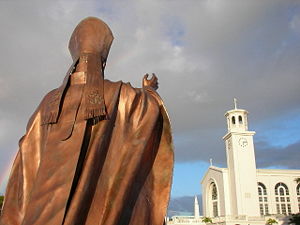
Traditional Chamorro culture is visually manifested in dance, sea navigation, unique cuisine, fishing, games (such as batu, chonka, estuleks, and bayogu), songs and fashion influenced by the immigration of peoples from other lands. Spanish policy during colonial rule (1668-1898) was one of conquest and conversion to Roman Catholicism. This led to the gradual elimination of Guam's male warriors and displacement of the Chamorro people from their lands. In spite of the social upheavals, Guam's matriarchs — known as "I Maga'håga" — continued the indigenous culture, language, and traditions.
Historian Lawrence Cunningham in 1992 wrote, "In a Chamorro sense, the land and its produce belong to everyone. Inafa'maolek, or interdependence, is the key, or central value, in Chamorro culture … Inafa'maolek depends on a spirit of cooperation. This is the armature, or core, that everything in Chamorro culture revolves around. It is a powerful concern for mutuality rather than individualism and private property rights."
The core culture or Pengngan Chamorro is comprised of complex social protocol centered upon respect: From the kissing of the hands of the elders (inspired by the kissing of a Roman Catholic bishop's ring by those whom he oversees), passing of legends, chants, and courtship rituals, to a person requesting forgiveness from spiritual ancestors when entering a jungle or ancient battle grounds. Other practices predating Spanish conquest include galaide' canoe-making, making of the belembaotuyan (a string musical instrument made from a gourd), fashioning of åcho' atupat slings and slingstones, tool manufacture, Måtan Guma' burial rituals and preparation of herbal medicines by Suruhanu.
Master craftsmen and women specialize in weavings, including plaited work (niyok- and åkgak-leaf baskets, mats, bags, hats, and food containments), loom-woven material ( kalachucha-hibiscus and banana fibre skirts, belts and burial shrouds), and body ornamentation (bead and shell necklaces, bracelets, earrings, belts and combs made from tortoise shells).
Today only few masters exist to continue traditional art forms. The cosmopolitan nature of Guam poses challenges for Chamorros struggling to preserve their culture and identity amidst forces of acculturation. The increasing numbers of Chamorros, especially Chamorro youth, relocating to the U.S. Mainland has further complicated both definition and preservation of Chamorro identity.
Government and politics
Guam is governed by a popularly elected governor and a unicameral 15-member legislature, whose members are known as senators. Guam elects one non-voting delegate, currently Madeleine Z. Bordallo, to the United States House of Representatives. Citizens in Guam vote in a straw poll for their choice in the U.S. Presidential general election, but since Guam has no votes in the Electoral College, the poll has no real effect. However, in sending delegates to the Republican and Democratic national conventions, Guam does have influence in the national presidential race, though these convention delegates are elected by local party conventions rather than voters in primaries.
In the 1980s and early 1990s, there was a significant movement in favour of the territory becoming a commonwealth, which would give it a level of self-government similar to Puerto Rico and the Northern Mariana Islands. However, the federal government rejected the version of a commonwealth that the government of Guam proposed, due to it having clauses incompatible with the Territorial Clause (Art. IV, Sec. 3, cl. 2) of the U.S. Constitution. Competing movements with less significant influence exist which advocate political independence from the United States, statehood, union with the Northern Mariana Islands as a single territory, or union with the current U.S. state of Hawaii.
Villages and military bases
Guam is divided into municipalities commonly called villages: Agana Heights, Agat, Asan‑Maina, Barrigada, Chalan‑Pago‑Ordot, Dededo, Hagåtña, Inarajan, Mangilao, Merizo, Mongmong‑Toto‑Maite, Piti, Santa Rita, Sinajana, Talofofo, Tamuning, Umatac, Yigo, Yona.
The U.S. military maintains jurisdiction over its bases, which cover approximately 39,000 acres (160 km²), or 29% of the island's total land area:
- Commander, Naval Forces Marianas, U.S. Navy – Sumay
- U.S. Coast Guard District 14 Sector Guam, – Sumay
- Andersen Air Force Base, U.S. Air Force – Yigo
- Apra Harbour, U.S. Navy – Orote peninsula
- Ordnance Annex, U.S. Navy – South Central Highlands (formerly known as Naval Magazine)
- Naval Computer and Telecommunications Station, U.S. Navy – Barrigada and Finegayan
- Joint Force Headquarters-Guam, Guam National Guard – Radio Barrigada and Fort Juan Muna
Economy
Guam's economy depends primarily on tourism, Department of Defense installations, and locally owned businesses. Although Guam receives no foreign aid, it does receive large transfer payments from the general revenues of the U.S. federal treasury into which Guam pays no income or excise taxes; under the provisions of a special law of Congress, the Guam treasury, rather than the U.S. treasury, receives federal income taxes paid by local taxpayers to include military and civilian federal employees assigned to Guam.
Commonly referred to as "America in Asia," Guam is a popular destination for Japanese tourists, and with over 20 large hotels, a Duty Free Shoppers Galleria, Pleasure Island district, indoor aquarium, Sandcastle Las Vegas-styled shows and other shopping and entertainment features in its chief tourism city of Tumon. It is a relatively short flight from Asia or Australia compared to Hawaii, with hotels and ten golf courses catering to over a million tourists per year. Although 90 percent of tourists are Japanese, Guam receives a respectable number of tourists from South Korea, Philippines, and Taiwan. Significant sources of revenue include duty-free designer shopping outlets, and the American-style malls: Micronesia Mall, Guam Premier Outlets, and the Agana Shopping Centre.
The economy had been stable since 2000 due to increased tourism, mainly from Japan, but took a recent downturn along with most of Asia. It is expected to stabilize well ahead of the U.S. Marine Corps' Third Marine Expeditionary Force, currently in Okinawa (appr. 8000 Marines, along with their 10,000 dependents), transfer to Guam between 2010-2014 but will cause an unprecedented 25% increase in the island's overall population. The programmed buildup by the Department of Defense on Guam is being categorized as the largest military buildup in the history of the United States military. Guam has a 14% unemployment rate, and the government suffered a $314 million shortfall in 2003.
The Compacts of Free Association between the United States, the Federated States of Micronesia, the Republic of the Marshall Islands and the Republic of Palau accorded the former entities of the Trust Territory of the Pacific Islands a political status of "free association" with the United States. The Compacts give citizens of these island nations generally no restrictions to reside in the United States (also its territories), and many were attracted to Guam due to its proximity, environmental, and cultural familiarity. Over the years, it was claimed by some in Guam that the territory has had to bear the brunt of this agreement in the form of public assistance programs and public education for those from the regions involved, and the federal government should compensate the states and territories affected by this type of migration. Over the years, Congress had appropriated "Compact Impact" aids to Guam, the Northern Mariana Islands and Hawaii, and eventually this appropriation was written into each renewed Compact. Some, however, continue to claim the compensation is not enough or that the distribution of actual compensation received is significantly disproportionate.
Transportation and communications
Most of the island has state of the art mobile phone services while digital cable and high speed internet are now widely available through either cable or DSL. Guam was added to the North American Numbering Plan (NANP) in 1997 (country code 671 became NANP area code 671), removing the barrier of high cost international long-distance calls to the U.S. Mainland.
As Guam is also part of the U.S. Postal System ("state" code: GU, ZIP code range: 96910-96932), mail to Guam from the U.S. mainland is considered domestic and no additional charges are required. Private shipping companies, such as UPS, DHL or FedEx, however, have no obligation to and do not regard Guam as domestic. The speed of mail traveling between Guam and the states varies depending on size. Light, first-class items generally take less than a week to or from the mainland, but larger first-class or Priority items can take a week or two. Fourth-class mail, such as magazines, are transported by surface after reaching Hawaii. Most residents use post office boxes or private mail boxes, although residential delivery is becoming increasingly available. Incoming mail not from the Americas should be addressed to "Guam" instead of "USA" to avoid being routed the long way through the U.S. mainland and possibly charged a higher rate (especially from Asia).
The Commercial Port of Guam is the island's lifeline since just about every product must be shipped into Guam for its consumers. The Port is also the regional transhipment hub for over 500,000 customers throughout the Micronesian region. The Port also is the shipping and receiving point for containers designated for the island's DoD installations, Andersen Air Force Base and Commander, Naval Forces Marianas and eventually the Third Marine Expeditionary Force.
Guam is served by the Antonio B. Won Pat International Airport, which is a regional hub for Continental Micronesia. The island is outside the United States customs zone and maintains its own customs agency and jurisdiction. Therefore, the U.S. Customs and Border Protection only carries immigration (but not customs) functions for incoming flights. Since Guam is under federal immigration jurisdiction, passengers arriving directly from the States skip immigration and directly proceed to customs. However, due to the Guam-only visa waiver program for certain Asian tourists, an eligibility pre-clearance check is carried on Guam for flights to the States. For travel to and from the Northern Mariana Islands (which are outside of U.S. immigration jurisdiction), a full inspection is performed though American citizens do not need a passport. Traveling between Guam and the States through a foreign point (for example, a Japanese airport), however, requires a passport.
Most residents travel within Guam using personally owned vehicles. The local government currently outsources the only public bus system (Guam Mass Transit Authority), and some commercial companies operated buses between tourist-frequented locations.
Ecological issues
Guam exemplifies the effects of bioinvasion.
The brown tree snake
Thought to be a stowaway on a U.S. military transport near the end of World War II, the slightly venomous—but rather harmless— brown tree snake (Boiga irregularis) came to Guam and killed virtually all of the native bird population on an island that has no native species of snake; this snake has no natural predators on the island. Although some studies have suggested a high density of the brown tree snake, residents rarely see these nocturnal snakes. Prodigious climbers, the snakes cause frequent blackouts by shorting across lines and transformers.
Other invasive animal species
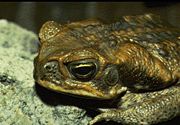
From the seventeenth through nineteenth centuries, the Spanish introduced pigs, dogs, chickens, the Philippine deer (Cervus mariannus), black francolins, and water buffalo. Water buffalo, known as carabao locally, have cultural significance. Herds of these animals obstruct military base operations and harm native ecosystems. After birth control and adoption efforts were ineffective, the U.S. military began euthanizing the herds leading to organized protests from island residents.
Other introduced species include cane toads imported in 1937, the giant African Snail (an agricultural pest introduced during WWII by Japanese occupation troops) and more recently frog species which could threaten crops in addition to providing additional food for the brown tree snake population. Reports of loud chirping frogs, known as coquí, that may have arrived from Hawaii have led to fears that the noise could even threaten Guam's tourism.
Introduced feral pigs and deer, over-hunting, and habitat loss from human development are also major factors in the decline and loss of Guam's native plants and animals.
Threats to indigenous plants
Invading animal species are not the only threat to Guam's native flora. Tinangaja, a virus affecting coconut palms, was first observed on the island in 1917 when copra production was still a major part of Guam's economy. Though coconut plantations no longer exist on the island, the dead and infected trees that have resulted from the epidemic are seen throughout the forests of Guam. Also during the past century, the dense forests of northern Guam have been largely replaced by thick tangan tangan brush ( Leucaena-native to the Americas). Much of Guam's foliage was lost during World War II. In 1947, the U.S. military introduced tangan tangan by seeding the island from the air to prevent erosion. In southern Guam, non-native grass species also dominate much of the landscape.
Wildfires
Wildfires plague the forested ("boonie" or "jungle") areas of Guam every dry season despite the island's humid climate. Most fires are man-caused with 80 percent resulting from arson. Poachers often start fires to attract deer to the new growth. Invasive grass species that rely on fire as part of their natural life cycle grow in many regularly burned areas. Grasslands and "barrens" have replaced previously forested areas leading to greater soil erosion. During the rainy season sediment is carried by the heavy rains into the Fena Lake Reservoir and Ugum River leading to water quality problems for southern Guam. Eroded silt also destroys the marine life in reefs around the island. Soil stabilization efforts by volunteers and forestry workers to plant trees have had little success in preserving natural habitats.
Aquatic preserves
As a vacation spot for scuba divers, efforts have been made to protect Guam's coral reef habitats from pollution, eroded silt, and overfishing that have led to decreased fish populations. In recent years the Department of Agriculture, Division of Aquatic and Wildlife Resources has established several new marine preserves where fish populations are monitored by biologists. Prior to adopting USEPA standards, portions of Tumon bay were dredged by the hotel chains in order to provide a better experience for hotel guests. Tumon Bay has since been made into a preserve. A federal Guam National Wildlife Refuge in northern Guam protects the decimated sea turtle population in addition to a small colony of Mariana fruit bats.
|
|
|---|
Education
Primary and secondary schools
- See also: List of schools in Guam
The Guam Public School System serves the entire island of Guam. In 2000, 32,000 students attended Guam's public schools. Guam Public Schools have struggled with problems such as high dropout rates and poor test scores. Guam's educational system has always faced unique challenges as a small community located 6,000 miles (9,700 km) from the U.S. mainland with a very diverse student body including many students who come from backgrounds without traditional American education. An economic downturn in Guam since the mid 1990s has compounded the problems in schools. In 1998, the U.S. Department of Defense opened schools for children of American military personnel. DoDEA schools, which also serve children of some federal civilian employees, had an attendance of 2,500 in 2000. The four schools operated by DoDEA are Andersen Elementary School, Andersen Middle School, McCool Elementary/Middle School, and Guam High School.
Colleges and universities
The University of Guam, and Guam Community College offer courses in higher education.


